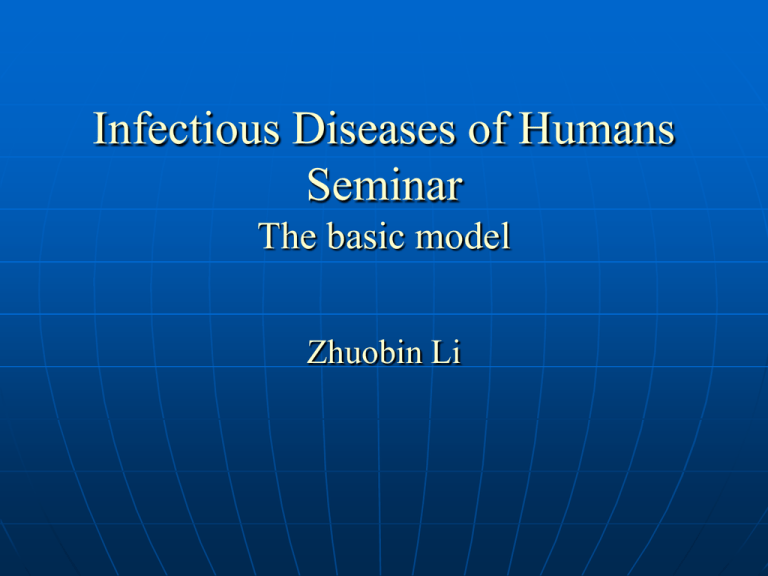Age structured model I
advertisement

Infectious Diseases of Humans Seminar The basic model Zhuobin Li Outline Framework of the basic model Basic reproduction number, R0 Average age of infection Transmission parameter, Frame work of the basic model Assumption • Previous model Age-specific host death rate, per capita Age-specific recovery rate Age-specific disease-induced death rate ‘force of infection’ at time t Frame work of the basic model Assumption • X(a),Y(a),and Z(a) are time independent • Birth rate and death rate are exactly balanced • Ignore mortality associated with the infection is assumed to be zero Frame work of the basic model Model Frame work of the basic model Boundary condition Frame work of the basic model Solve the model where Survivorship function Frame work of the basic model Frame work of the basic model Basic reproductive number R 0 R0 for a microparasite • The basic reproductive number R0, is essentially the average number of successful offspring that a parasite is intrinsically capable of producing. • For a microparasite, R0 is defined as the average number of secondary infections produced when one infected individual is introduced into a host population where everyone is suscetible. • R 0 >1 is the condition of being capable of invading and establishing itself within a host population Basic reproductive rate R 0 R0 for a microparasite • At the equilibrium, the rate of the susceptible being infected is balanced against a rate of newly susceptible individuals appearing. • At the equilibrium, each infection will be on average produce exactly one secondary infection; R=R0 x*=1 where x* is the fraction of the host population that is susceptible at equilibrium Basic reproductive rate R 0 R0 for a this model • It seems to more plausible that the net rate of acquisition of new infectious is proportional to than to . “doubling the number of susceptibles in a school is arguably more likely to double the incidence of infection than is doubling the number of infectious individual” • Basic reproductive number Basic reproductive number R Two types of mortality Type I: Type II: where L is life expectancy. 0 Basic reproductive number R Two types of mortality Type I: Type II: Survivor ship function: 0 Basic reproductive number R Two types of mortality Type I: Type II: 0 Basic reproductive number R 0 Two types of mortality Type I: Type II: Approximation of L “The difference between L and G can be significant, especially in some developing country. For an example, life expectancy L of India is around 40 years, while births are around 40 per 1000 per annum which corresponds to G~25 years” Average age at infection The average age at which individuals acquire infection, A. Type I Type II Average age at infection The average age at which individuals acquire infection based on the proportions susceptible. If λ is age-dependent, then Average age at infection Come back to basic reproductive number Type I: Transmission parameter, Transmission parameter • Combines a multitude of epidemiolagical, environmental, and social factors that affect transmission rates • is “ force of infection”, the per capita rate of acquisition of infection. If is time dependent, (t)t represents the probability that a given susceptible host will become infected in the small time interval t. Transmission parameter, Type I: Type II:



